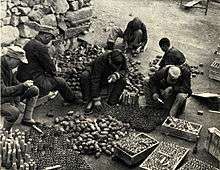Model 24 grenade
| Model 24 Stielhandgranate | |
|---|---|
|
German stick grenade Model 24 | |
| Type | Hand grenade |
| Place of origin |
|
| Service history | |
| In service | 1915–1945 |
| Production history | |
| Designed | 1915 |
| Specifications | |
| Weight | 595g |
| Length | 365 mm |
| Diameter | 70 mm |
|
| |
| Filling | Trinitrotoluene |
Detonation mechanism | 5 seconds |
The Model 24 Stielhandgranate (German, "stalk hand grenade") was the standard hand grenade of the German Army from World War I until the end of World War II. The very distinctive appearance led to it being called a "stick grenade", or a "potato masher" in British Army slang, and is today one of the most easily recognized infantry weapons of the 20th century.[1]
Design and operation
The stick grenade was introduced in 1915 and the design developed throughout World War I. A friction igniter was used; this method was uncommon in other countries, but widely used for German grenades.

A pull cord ran down the hollow handle from the detonator within the explosive head, terminating in a porcelain ball held in place by a detachable base closing cap. Pulling the cord dragged a roughened steel rod through the igniter causing it to flare up and start the five-second fuse burning.
These exposed pull cords had a tendency to accidentally snag and detonate the grenades while being carried so a threaded cap securing the cord and ball in the base of the grenade handle was added.
Stick grenades were stored in cases for transport, and their fuse assemblies inserted prior to going into combat — a reminder was stenciled on each explosive charge ("Vor Gebrauch Sprengkapsel einsetzen" "Before use insert detonator").
With its high-explosive charge encased in a thin sheet steel can, the Model 24 was fundamentally a "concussion grenade" which relied on blast effect, rather than an anti-personnel fragmentation grenade. A serrated fragmentation sleeve ("Splitterring") was adopted in 1942 which could be slid over the head of the grenade. Fragments of the sleeve would be scattered on detonation, making the grenade more effective against personnel.
The stick provided a lever, significantly improving the throwing distance. The Model 24 could be thrown approximately 27 metres (30 yd) to 37 metres (40 yd), whereas the British Mills bomb could only be thrown about 14 metres (15 yd)[2] (however the British War Office report "WO 291/472 Performance and handling of HE grenades" gives an average figure for a standing throw of a Mills bomb as 27 metres (30 yd), when crouched 23 metres (25 yd) and lying 22 metres (24 yd)). The stick design also reduced the risk of the grenade rolling downhill back towards the thrower when used in hilly terrain or in urban areas. However, the additional length of the handle meant that fewer could be carried.
The grenades were extremely useful for clearing out entrenched infantry positions. Although they were not individually very effective against armoured vehicles and fortifications, the grenade could be used in an improvised "bundle" style where additional explosive heads (without their sticks) were wired around the central stick grenade. These were known as Geballte Ladung ("bundled charge" or "concentrated charge").
Variants

The Stielhandgranate went through numerous variants, several versions being deployed in World War I before a settled design emerged in 1917. Into World War II the grenade had a slightly smaller head and the unnecessary belt clip was removed.
Each change was essentially a move towards a lighter device which was easier and less costly to manufacture, and to these ends the Model 24 was eventually superseded by the simpler Model 43 grenade, although the former continued to be used through to the end of the war.
Numerous Ersatz variations were developed towards the end of the war as Germany's resources and production capabilities dwindled. Other than the common high explosive (HE) stick grenade, Germany produced a smokescreen version, which existed in an early and later model and is easily identified by a white band around the handle and (on the later model) a grooved handgrip to permit a user to differentiate it from the regular explosive version in the dark by touch alone. As cold climate could cause the Model 24 to fail to detonate, a special explosive powder was used in those destined for Russia, and these were marked with "K" (Kalt or "cold") on the can. Inert (non-exploding) training versions were also produced.
The stick grenade concept was also used in the Far East by the Imperial Japanese Army as the Type 98 grenade and the Chinese National Revolutionary Army in World War II as the Type 23, and later the Chinese Communists, who supplied the locally manufactured "Type 67" to the NLF and People's Army of Vietnam.

Users

 German Empire
German Empire.svg.png) Nazi Germany
Nazi Germany.svg.png) Austria-Hungary
Austria-Hungary Independent State of Croatia
Independent State of Croatia.svg.png) Kingdom of Hungary[3]
Kingdom of Hungary[3] Soviet Union
Soviet Union Republic of China
Republic of China People's Republic of China
People's Republic of China Indonesia
Indonesia Finland
Finland Sweden
Sweden
See also
| Wikimedia Commons has media related to Stielhandgranate 24. |
- List of World War II firearms of Germany
- Model 39 grenade
- Model 43 grenade
- RGD-33 Grenade
- Splitterring
References
- ↑ Bishop, Chris (1998), The Encyclopedia of Weapons of World War II, New York: Orbis Publishing Ltd., ISBN 0-7607-1022-8.
- ↑ The Discovery Channel: "Weaponology: Episode 10: Frags, Pineapples, and RPG's", 2007.
- ↑ Tibor, Rada (2001). "Német gyalogsági fegyverek magyar kézben" [German infantry weapons in Hungarian hands]. A Magyar Királyi Honvéd Ludovika Akadémia és a Testvérintézetek Összefoglalt Története (1830-1945) (in Hungarian). II. Budapest: Gálos Nyomdász Kft. p. 1114. ISBN 963-85764-3-X.